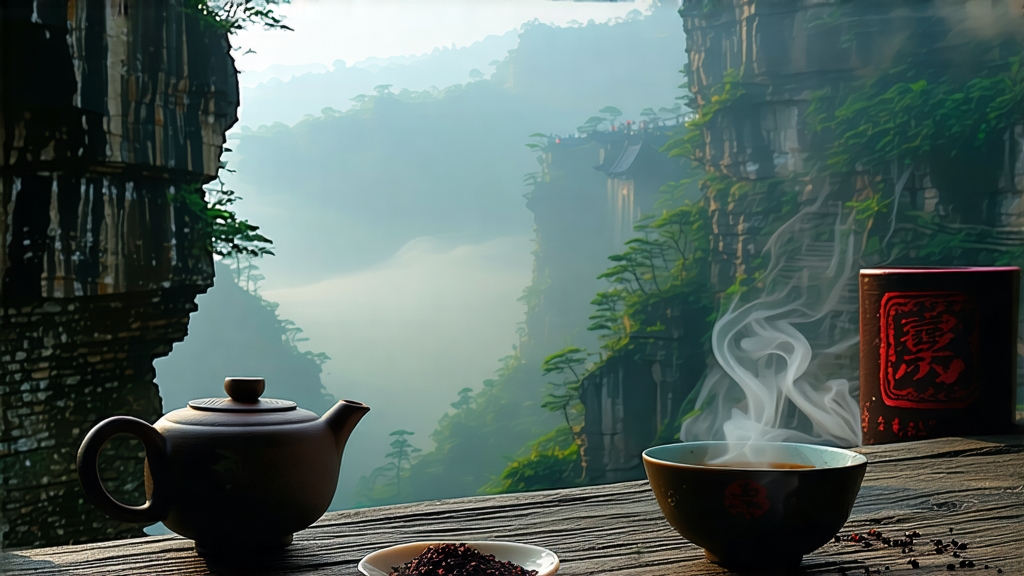
When Chinese tea lovers speak of “rock rhyme”—the mineral melody that lingers on tongue and memory—they are almost always talking about Da Hong Pao, the great Red-Robe Oolong that grows on the sheer cliffs of northern Fujian’s Wuyi Mountains. Revered since the early Ming dynasty, this tea is less a single cultivar than a micro-ecology of myth, geology, and human craftsmanship. To understand it is to step into a landscape where vertical granite towers disappear into cloud, where monks once suspended themselves on ropes to harvest leaves, and where every kilo of finished tea still passes through more than thirty pairs of skilled hands.
Legend dates the birth of Da Hong Pao to 1385, when a Ming court scholar, cured of fever by tea plucked from six mother bushes on Jiulongke (“Nine-Dragon Cave”), draped his imperial scarlet robe over the shrubs in gratitude. The emperor, hearing the tale, declared the bushes “Cha Wang” (Tea King) and ordered annual harvests reserved for the throne. While romantic, the story masks a deeper history: Buddhist and Taoist monasteries had already cultivated tea in Wuyi for three centuries, trading compressed “dragon balls” along the Nine-Bend River to Canton and beyond. By the 17th century, Wuyi yancha (“cliff tea”) was filling the holds of Dutch East India ships, its dark, twisted leaves baptized “Bohea” in European salons. Da Hong Pao, then a collective name for the highest grade of yancha, became the most valuable lot at the Canton tea hongs, fetching up to twice the price of silver by weight.
Today the name Da Hong Pao is legally protected under China’s Geographic Indication system; only leaf picked within the 60 km² core scenic zone of Wuyi may bear the title. Inside that zone three distinct styles coexist. “Mother-Tree Tea,” harvested from the 350-year-old bushes in Jiulongke, was last picked in 2006 and now exists only in 20 g government-sealed vaults; a single gram has sold at auction for USD 1.2 million. “Pure-Tree Tea” comes from cuttings of those originals, vegetatively propagated and grown in the same micro-terroir, yielding less than 30 kg a year. The third and most accessible category is “Blended Da Hong Pao,” a skillful marriage of leaves from authorized bushes such as Que She (“Sparrow Tongue”), Bei Dou (“North Star”), and the heartier Qidan (“Strange Dan”), assembled to recreate the mother-tree profile. Each spring, Wuyi’s tea bureaus issue numbered batch certificates; collectors scan QR codes to verify elevation, plot number, and charcoal master.
Terroir is everything. The Wuyi range is a 550-million-year-old rift valley whose weathered granite and tuff have eroded into a mineral-rich, slightly alkaline soil. Day-night temperature swings of 15 °C force slow growth, while constant mist filters sunlight into diffuse amber that thickens leaf cuticles. The cliffs themselves act as radiant heaters at night, releasing stored daytime warmth and creating a unique “cold at dusk, warm at dawn” rhythm. These stresses concentrate aromatic precursors—linalool, geraniol, jasmine lactone—while the alkaline substrate pumps potassium, magnesium, and fluoride into the leaf, giving Da Hong Pao its signature “yan yun” (rock rhyme), a cooling, wet-stone sensation that arrives minutes after swallowing.
Plucking begins at Qingming (early April) when two leaves and a bud reach 45 mm length. Pickers climb bamboo ladders lashed to iron pegs hammered into cliff faces, starting at dawn to finish before the sun burns off dew. Leaves are lowered in wicker baskets on hemp ropes, a method unchanged since the 18th century. Once in the village workshop, the leaf undergoes the most labor-intensive oolong craft in China. First comes sun-withering on bamboo screens for 20–30 minutes, followed by indoor “cooling” on water-veined slate tables where temperature is maintained at 22 °C and humidity at 68 %. The critical “yao qing” (shaking-green) phase begins at dusk: 7–9 rounds of gentle tumbling in rattan trays, each lasting 3 minutes and spaced 90 minutes apart. Between rounds the leaf rests, edges bruise, and oxidation commences from the rim inward, creating